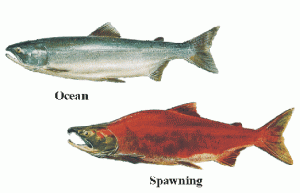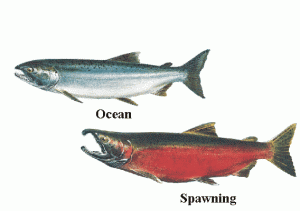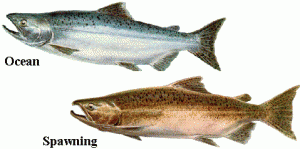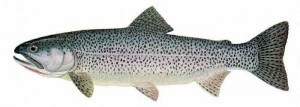Pink: Oncorhynchus gorbuscha
Picture: US Fish and Wildlife Service
Also known as humpies, due to the very large hump males get just behind the head, during the spawning phase. Although they are the smallest of the species, they are the most abundant in number. They spend the least amount of time in freshwater, spawning in two year cycles very close to the mouth of streams with little to no upstream migration. While in the ocean they appear to have steel blue to blue green backs, silver sides, and a white belly with large oval spots covering their back, adipose fin and both lobes of the caudal fin. During the spawning phase pinks have dark backs with a pinkish wash and green blotches on their sides. These fish generally live for 2 years, are about 18-24in in length, and weigh about 3-5 lbs.
Sockeye: Oncorhynchus nerka
PICTURE: US FISH AND WILDLIFE SERVICE
Also known as the redfish, red, or blue-black, they are the most important commercial species. Sockeye have long gill rakers as they primary feed on plankton when in the ocean. They have the greatest life history diversity and can spend anywhere from 3 months to 3 years in freshwater. They will spawn near shorelines, the bottom of lakes, or hundreds of miles upstream. Fry of this species rears almost exclusively in lakes. While in the ocean they are greenish blue on top of the head and back, silvery on the sides, and white to silver on the belly. During the spawning phase the head and caudal fin become bright green and the body turns scarlet. Land locked populations of this species are known as kokanee. These fish generally live 2-6 years, are about 21-26in in length, and weigh about 4-7lbs.
Coho: Oncorhynchus kisutch
PICTURE: US FISH AND WILDLIFE SERVICE
Also known as a silver, coho are the second least abundant (following Chinook) salmon. While they are one of the most commercially sought after species they make up only 7-10% of the commercial salmon fishery. They spend 1-2 years in freshwater, and prefer near shore feeding grounds. Coho usually travel less then 100 miles from the moth of their stream for reproduction with the exception of a few populations that do travel over a thousand miles. While in the ocean they have dark metallic blue or greenish backs with silver sides and a light belly. They have small black spots on their backs and the upper lobe of the tail. Another distinguishing feature is their gum line which is white. Spawning colors are dark with reddish coloration on their sides. These fish generally live 3-5 years, are about 24-28in in length, and weigh about 5-10 lbs.
Chum: Oncorhynchus keta
PICTURE: US FISH AND WILDLIFE SERVICE
This salmon is also known as the dog, or calico salmon. Chum comes from a word meaning variegated coloration in the native language. They have the most widely distributed population and the greatest biomass. They are the second largest salmon (following the Chinook). Most populations reproduce near the mouth of their stream. When in the ocean they are metallic, greenish-blue along the back with black speckles which closely resemble sockeye and coho. During the spawning phase males get vertical bars in reds, greens, and purples, while females get a black horizontal stripe. These fish generally live 3-5 years, are 21-31in in length, and weigh about 6.5-12.5lbs.
Chinook: Oncorhynchus tshawytscha
PICTURE: US FISH AND WILDLIFE SERVICE
Also known as the king, tyee, or blackmouth, the name Chinook came from the native peoples of the Columbia River and is considered a proper name and thus is always capitalized. They are the largest, but least abundant salmon. When in the ocean they have bluish-green backs and silver sides with irregular spotting on the back, dorsal fin, and both lobes of the tail. Another distinguishing characteristic is their black gum line. Spawning colors are olive brown to dark brown in color. Males also develop a hocked snout. These fish live about 3-6 years, are 28-40in in length, and weigh about 10-30 lbs.
Steelhead: Oncorhynchus mykiss
Picture: Trout Unlimited California
Commonly known as the steelhead trout, coastal rainbow trout, silver trout, salmon trout, ironhead, or steelie this salmon has historically been idolized as a trophy game fish. This species consists of a two runs, a winter and a summer. They differ from other salmon species in that hey can return multiple times to spawn. However the number of returning spawners decreases significantly from year to year with few fourth year spawners. There is a higher mortality rate during steelhead spawning season as they do not feed while in freshwater. They are characterized by their metallic blue backs and silvery sides, and black spots on the back, dorsal and caudal fins. Spawning colors are darker with males having a pink or red band on the sides. They do not have a red dash under lower jaw which distinguishes steelhead from coastal cutthroat. These fish live about 1-4 years, are about 20-30 in in length, and weigh about 5-20 lbs.
Cutthroat: (Oncorhynchus clarki clarki)
PICTURE: US FISH AND WILDLIFE SERVICE
Also known as sea-run cutthroat trout, coastal cutthroat trout, red-throated trout, sea trout, and blueback trout. This species has three life history options: two types spend their entire lives in freshwater while only one type is anadromous. Cutthroat are characterized by a red or orange streak along the inner edge of the lower jaw. They have a greenish blue back tending towards metallic blue, silvery sides, and distinct black spots on the back, head, anal fin, tail, and sides. The spots on the sides extend below the lateral line. These fish live an average of 3-6 years, fourth and fifth year spawners reach 17-19 in in length, and weigh about 1-6 lbs.
Anderson, Genny. “Salmon Species Diversity.” Marine Science. N.p., March 2010. Web. 31 Jan 2012.
Pauley, Gilbert, Bruce Bortz, et al. “Steelhead Trout.” Species Profiles: Life Histories and Environmental Requirements of Coastal Fishes and Invertebrates (Pacific Northwest). 82. (1986): n. page. Print.
Pauley, Gilbert, Kevin Oshima, et al. “Sea-run Cutthroat Trout.” Species Profiles: Life Histories and Environmental Requirements of Coastal Fishes and Invertebrates (Pacific Northwest). 82.11.86 (1989): n. page. Print.







